
MP4 File Optimization Removing Unwanted Audio Tracks

“MP4 File Optimization: Removing Unwanted Audio Tracks”
While editing an MP4 (MPEG/MPG) clip, we may want to remove audio from the MP4 file completely instead of muting the audio and getting only the video stream as an output.
Sometimes we may want to remove audio from the original file and add a new sound tracker.
To help finish this task, Wondershare Filmora is the right choice. With it, you can either delete all audio tracks completely from MP4 to get the video with no audio in it at all. Or remove an extra audio track and only keep the one you like.
The following article will introduce a simple way of removing audio from video in whatever situation.
MP4 Audio Remover - Wondershare Filmora
Why Choose Wondershare Filmora
- Completely remove the audio from video to keep video-only stream;
- Or mute the audio of the video;
- Easily trim/crop/rotate video files on the timeline;
- Add effect/subtitle/watermark to enrich your video;
- Save and play your video on different devices, burn to DVD or upload online;
- Supported OS: Windows & Mac (above 10.11).
For Win 7 or later (64-bit)
For macOS 10.12 or later
Step 1: Import your MP4 file
Free download the audio track remover- Video Editor, install, and run it. Then the following interface will pop up. Click the “Import” button to add the video file you want to remove audio tracks.
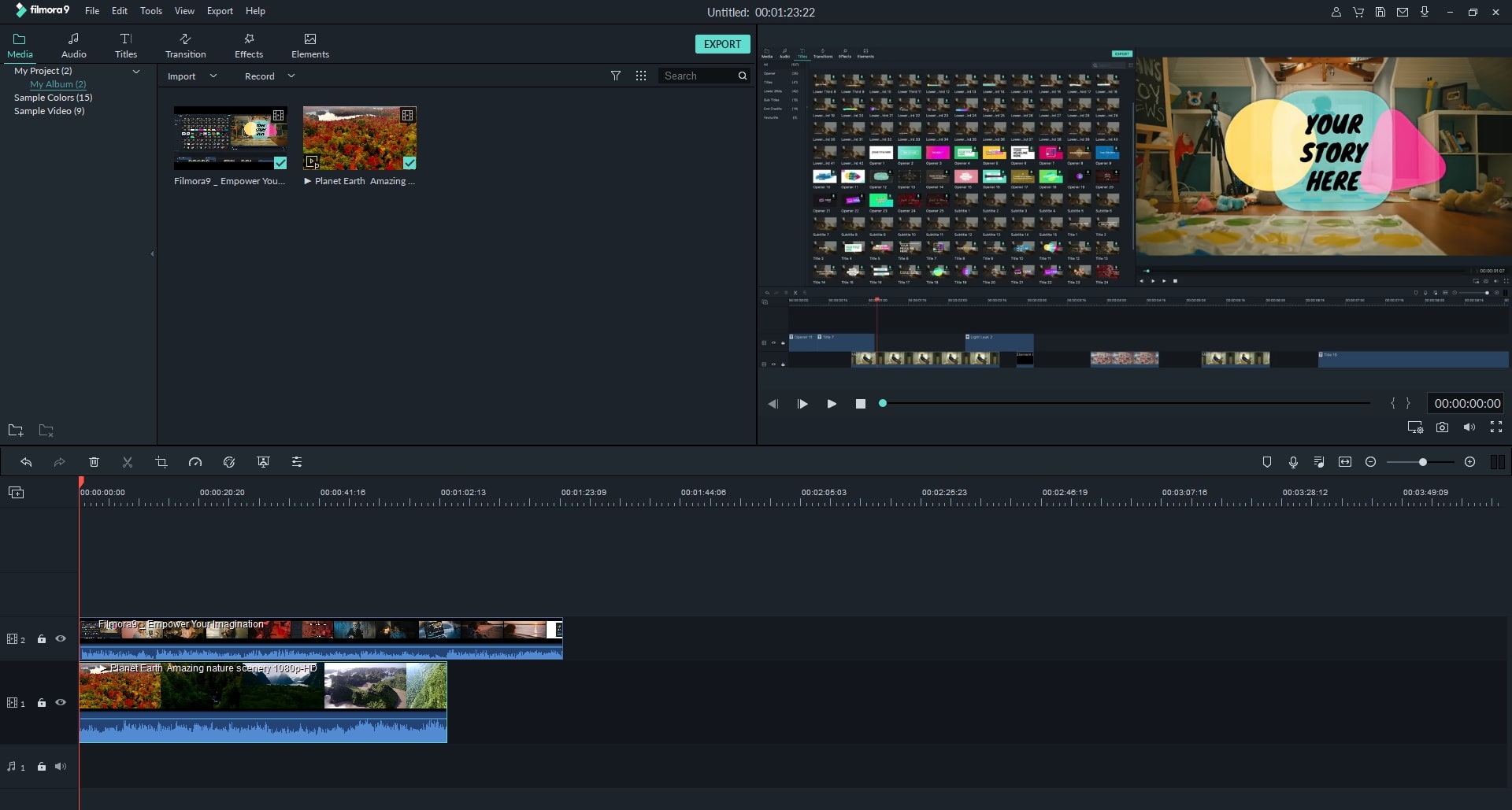
Step 2: Remove audio from the file
Drag-n-drop the mp4 file to the timeline, right-click and choose “Detach Audio” to detach the audio tracks from the original mp4 file. Then the separated audio track will appear in the Audio Timeline. You can right-click the audio and choose “Delete” to remove audio from mp4.
Note: if you want to add the new sound tracker, import the sound recordings you want to the media library and drag them to the audio timeline.
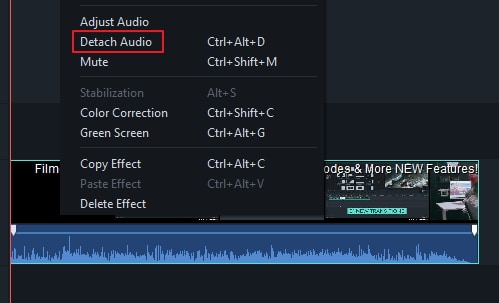
Step 3: Save the edited video
After that, hit “Export” to select the desired output way. You can set the output video format the same as the original one or set the output video format to any other video formats. Then click the “Export” button to export the video. What’s more, you can save the edited file to iPhone, iPad PSP, etc., or directly upload it to YouTube for sharing with friends.
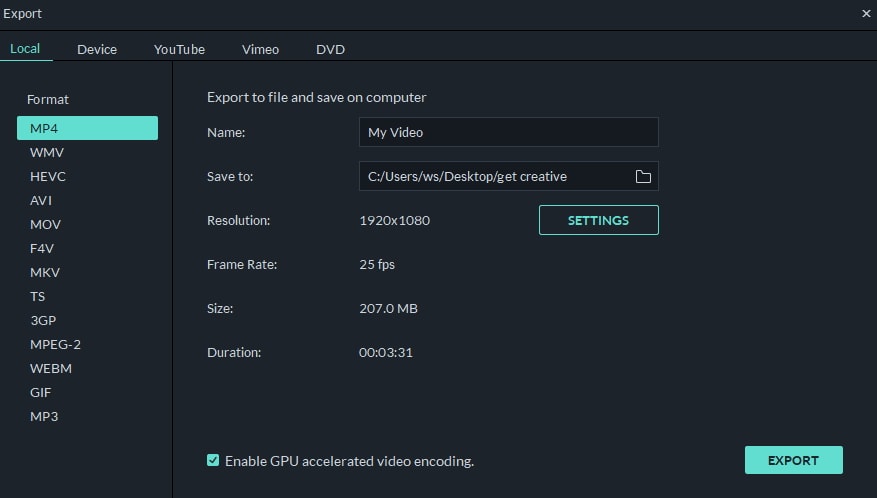
Bonus: Mute a Video with Filmora Video Editor with 1-click
Sometimes, you might wish to mute a video clip for many reasons, then the Filmora Video Editor, as the best MP4 Audio Extractor or Editor will help you do it with 1 simple click.
To reach it, you only need to drag and drop your targeted MP4 video into the timeline, and then, right-click on it and choose “Mute“ option. Then, click “Export” to export and save the edited videos.
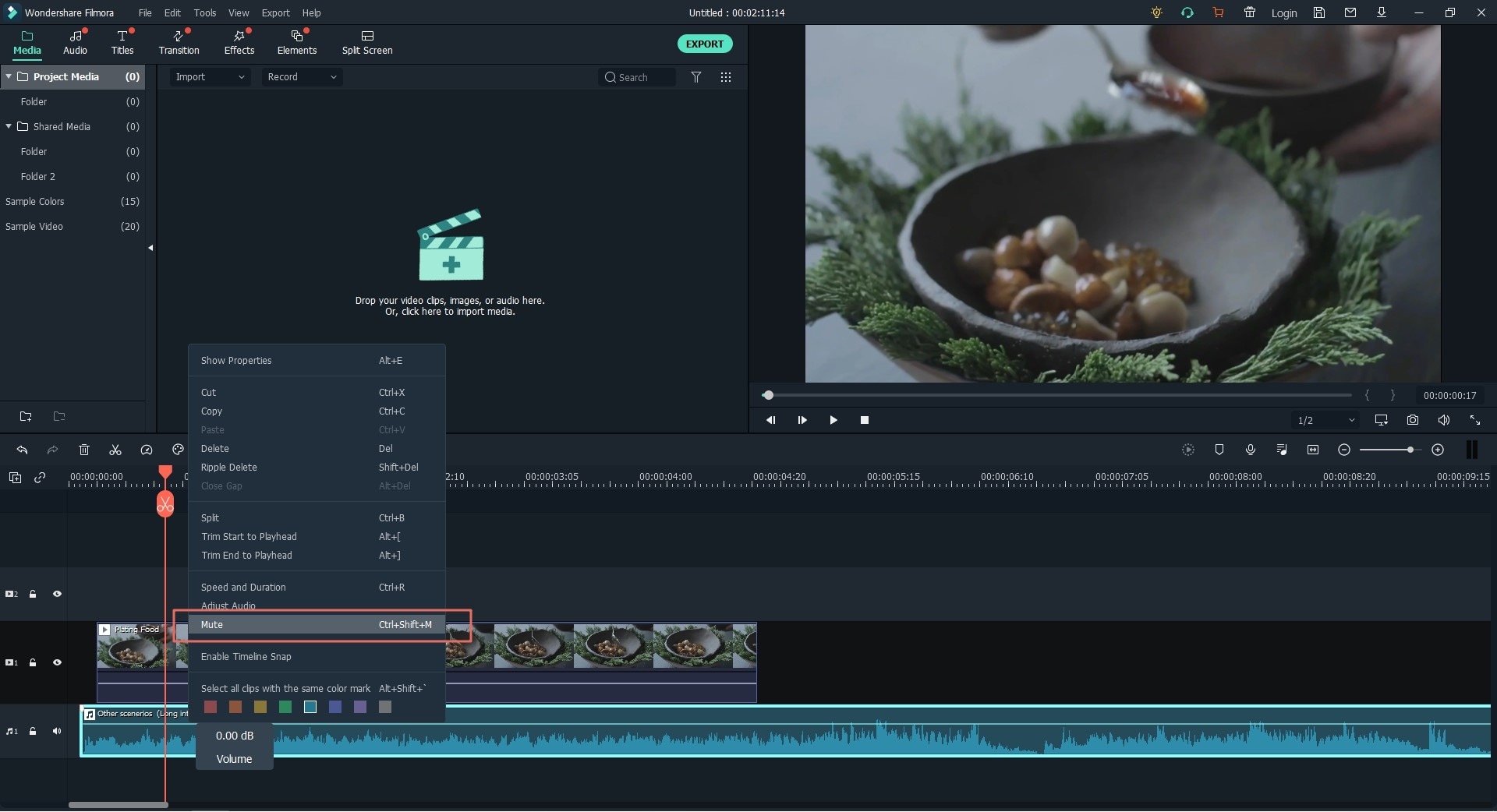
Conclusion
Now, it’s your turn to have a try. Above are the steps to remove audio from video. Leave a comment to let us know if you have any questions.
Versatile Video Editor - Wondershare Filmora
An easy yet powerful editor
Numerous effects to choose from
Detailed tutorials provided by the official channel
For Win 7 or later (64-bit)
For macOS 10.12 or later
Step 1: Import your MP4 file
Free download the audio track remover- Video Editor, install, and run it. Then the following interface will pop up. Click the “Import” button to add the video file you want to remove audio tracks.

Step 2: Remove audio from the file
Drag-n-drop the mp4 file to the timeline, right-click and choose “Detach Audio” to detach the audio tracks from the original mp4 file. Then the separated audio track will appear in the Audio Timeline. You can right-click the audio and choose “Delete” to remove audio from mp4.
Note: if you want to add the new sound tracker, import the sound recordings you want to the media library and drag them to the audio timeline.

Step 3: Save the edited video
After that, hit “Export” to select the desired output way. You can set the output video format the same as the original one or set the output video format to any other video formats. Then click the “Export” button to export the video. What’s more, you can save the edited file to iPhone, iPad PSP, etc., or directly upload it to YouTube for sharing with friends.

Bonus: Mute a Video with Filmora Video Editor with 1-click
Sometimes, you might wish to mute a video clip for many reasons, then the Filmora Video Editor, as the best MP4 Audio Extractor or Editor will help you do it with 1 simple click.
To reach it, you only need to drag and drop your targeted MP4 video into the timeline, and then, right-click on it and choose “Mute“ option. Then, click “Export” to export and save the edited videos.

Conclusion
Now, it’s your turn to have a try. Above are the steps to remove audio from video. Leave a comment to let us know if you have any questions.
Versatile Video Editor - Wondershare Filmora
An easy yet powerful editor
Numerous effects to choose from
Detailed tutorials provided by the official channel
For Win 7 or later (64-bit)
For macOS 10.12 or later
Step 1: Import your MP4 file
Free download the audio track remover- Video Editor, install, and run it. Then the following interface will pop up. Click the “Import” button to add the video file you want to remove audio tracks.

Step 2: Remove audio from the file
Drag-n-drop the mp4 file to the timeline, right-click and choose “Detach Audio” to detach the audio tracks from the original mp4 file. Then the separated audio track will appear in the Audio Timeline. You can right-click the audio and choose “Delete” to remove audio from mp4.
Note: if you want to add the new sound tracker, import the sound recordings you want to the media library and drag them to the audio timeline.

Step 3: Save the edited video
After that, hit “Export” to select the desired output way. You can set the output video format the same as the original one or set the output video format to any other video formats. Then click the “Export” button to export the video. What’s more, you can save the edited file to iPhone, iPad PSP, etc., or directly upload it to YouTube for sharing with friends.

Bonus: Mute a Video with Filmora Video Editor with 1-click
Sometimes, you might wish to mute a video clip for many reasons, then the Filmora Video Editor, as the best MP4 Audio Extractor or Editor will help you do it with 1 simple click.
To reach it, you only need to drag and drop your targeted MP4 video into the timeline, and then, right-click on it and choose “Mute“ option. Then, click “Export” to export and save the edited videos.

Conclusion
Now, it’s your turn to have a try. Above are the steps to remove audio from video. Leave a comment to let us know if you have any questions.
Versatile Video Editor - Wondershare Filmora
An easy yet powerful editor
Numerous effects to choose from
Detailed tutorials provided by the official channel
For Win 7 or later (64-bit)
For macOS 10.12 or later
Step 1: Import your MP4 file
Free download the audio track remover- Video Editor, install, and run it. Then the following interface will pop up. Click the “Import” button to add the video file you want to remove audio tracks.

Step 2: Remove audio from the file
Drag-n-drop the mp4 file to the timeline, right-click and choose “Detach Audio” to detach the audio tracks from the original mp4 file. Then the separated audio track will appear in the Audio Timeline. You can right-click the audio and choose “Delete” to remove audio from mp4.
Note: if you want to add the new sound tracker, import the sound recordings you want to the media library and drag them to the audio timeline.

Step 3: Save the edited video
After that, hit “Export” to select the desired output way. You can set the output video format the same as the original one or set the output video format to any other video formats. Then click the “Export” button to export the video. What’s more, you can save the edited file to iPhone, iPad PSP, etc., or directly upload it to YouTube for sharing with friends.

Bonus: Mute a Video with Filmora Video Editor with 1-click
Sometimes, you might wish to mute a video clip for many reasons, then the Filmora Video Editor, as the best MP4 Audio Extractor or Editor will help you do it with 1 simple click.
To reach it, you only need to drag and drop your targeted MP4 video into the timeline, and then, right-click on it and choose “Mute“ option. Then, click “Export” to export and save the edited videos.

Conclusion
Now, it’s your turn to have a try. Above are the steps to remove audio from video. Leave a comment to let us know if you have any questions.
Versatile Video Editor - Wondershare Filmora
An easy yet powerful editor
Numerous effects to choose from
Detailed tutorials provided by the official channel
Optimizing Pitch Alteration in Audacity: A Guide to Quality Retention
You may raise or lower the pitch of a pre-recorded song. Likewise, you may apply the pitch-changing effect in real-time sound recording. Change in pitch affects your noise in certain ways. For instance, it can help you sound younger. Similarly, it can convert the male voice into a female voice. Another notable use of the pitch-changing technique is that you can produce sounds like cartoons. So, changing pitch can add a unique touch to your voice. You can also change pitch when recording in Audacity. The following article covers details about the Audacity change pitch feature. Let’s get started.
In this article
01 What is pitch, and how does it work?
02 How to Change Pitch in Audacity?
Part 1: What is pitch, and how does it work?
Not all sounds are the same. Some vary in terms of amplitude, which makes them loud or quiet. In contrast, others vary in terms of pitch, which makes them high or low. Pitch is used to differentiate between the acute and flat notes in a sound wave. High-pitched sounds are likely to be shrilling, whereas the lower-pitched will be bassy. Pitch depends upon the frequency of the sound waves producing them. In short, notes at a higher frequency are high-pitched.
On the contrary, notes at lower frequencies are low-pitched. Changing a pitch of noise from low to high or vice versa is an art. Thus, sound recording and editing applications like Audacity come with the in-built effect that enables you to change the pitch of a sound.
Part 2: How to Change Pitch in Audacity?
Sound editing is becoming increasingly popular in music and other relevant industries. Several applications offer sound editing tools to serve the needs of the people. Pitch-changing is one of the common tools that people look for in sound editors.
Audacity is one of the notable software that allows users to change the pitch of the voice. It comes with an Audacity pitch shift mechanism to facilitate users. So, if you are editing sound in Audacity, changing the pitch is just a matter of a few clicks. Are you still wondering how you can apply the Audacity change pitch technique when editing? Here’s how you can do it in simple steps.
Step 1: Select the audio portion
Launch Audacity and add sound recordings you want to edit. Click on the timeline and drag to select the portion of the sound.
Note: Only the portion whose pitch you want to change.
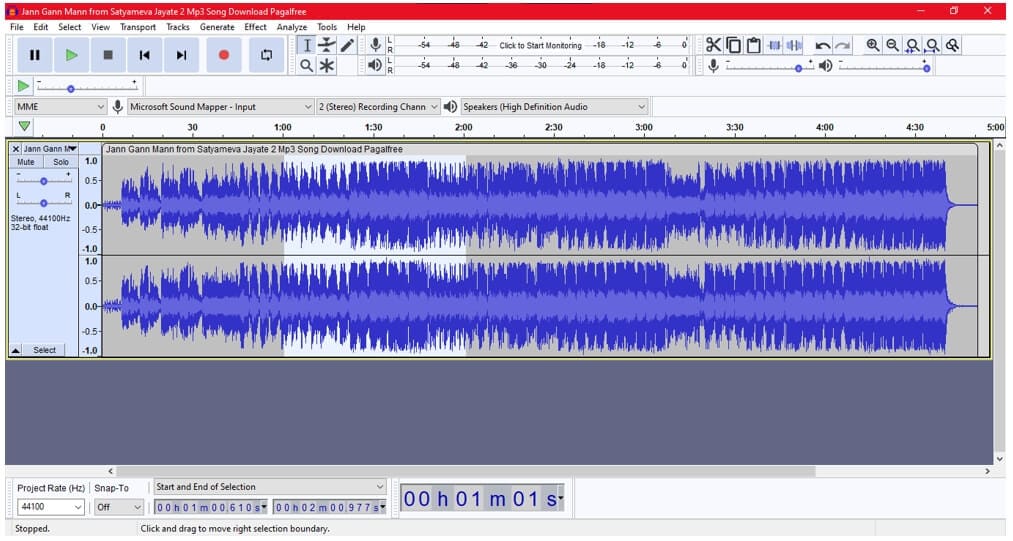
Step 2: Open Effect menu
Click on the Effect tab at the top right of the screen next to Generate. Select Pitch Change from the drop-down menu.
Note: You can also make other changes, such as Change Speed and Change Tempo option will let you alter the speed of the sound. So, the pitch can also be altered using this process.

Step 3: Adjust pitch
Drag the slider to alter the pitch of the sound and press the OK button to apply changes.
Note: To increase pitch, slide towards the right. Similarly, slide towards the left to a lower pitch. In addition, the pitch can also be changed by configuring From and To parameters.
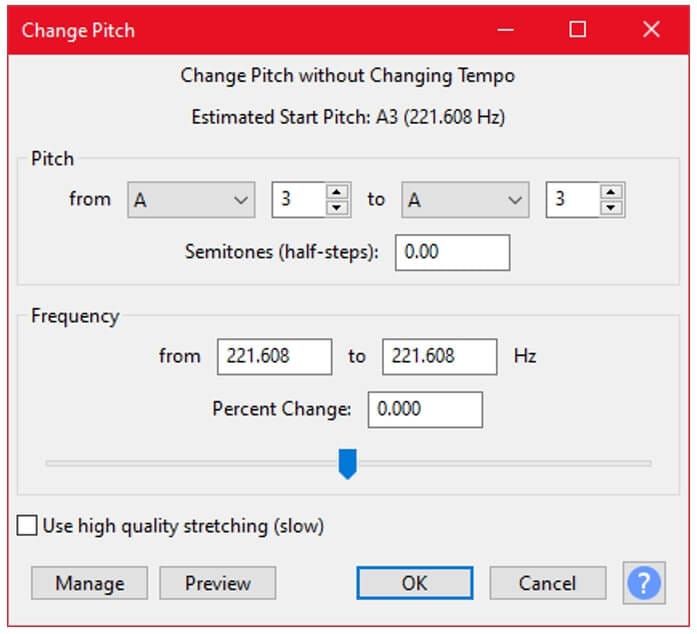
Bonus Section: How to Adjust Sound Louder in Audacity?
Volume in an audio file may or may not be ideal for use. Sometimes, the sound is too loud or low. Audacity can help you in such a situation. So, if you are editing sound recordings in Audacity, you can also fix the volume of the sound. The good thing to note is that you can adjust the sound in both directions, which implies you can easily amplify or reduce the volume in these open-source applications. Are you interested in knowing about the volume adjustment process in Audacity? If yes, we have summarized the process in simple steps. Let’s take a look.
Step 1: Add an audio file
Launch the software and click on File. Select Open and select the desired audio.
Note: It is not recommended to change the volume through the playback volume knob at the top right corner of the screen, as this will only increase the volume in your device. However, the actual volume of the audio will remain unchanged.
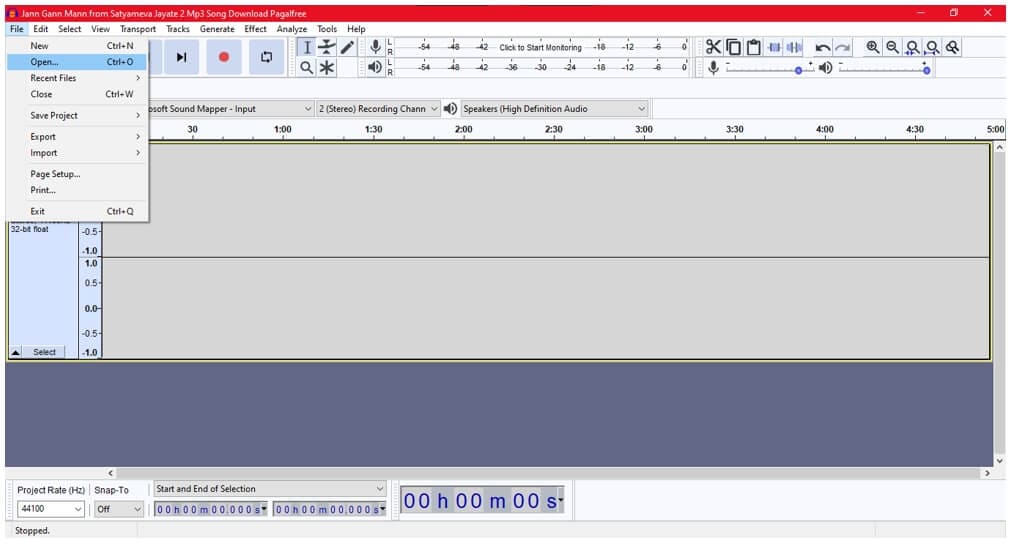
Step 2: Increase/Decrease audio gain
Change the gain of the audio at the left-hand side of the screen. Move the slider to adjust the volume to the desired level.
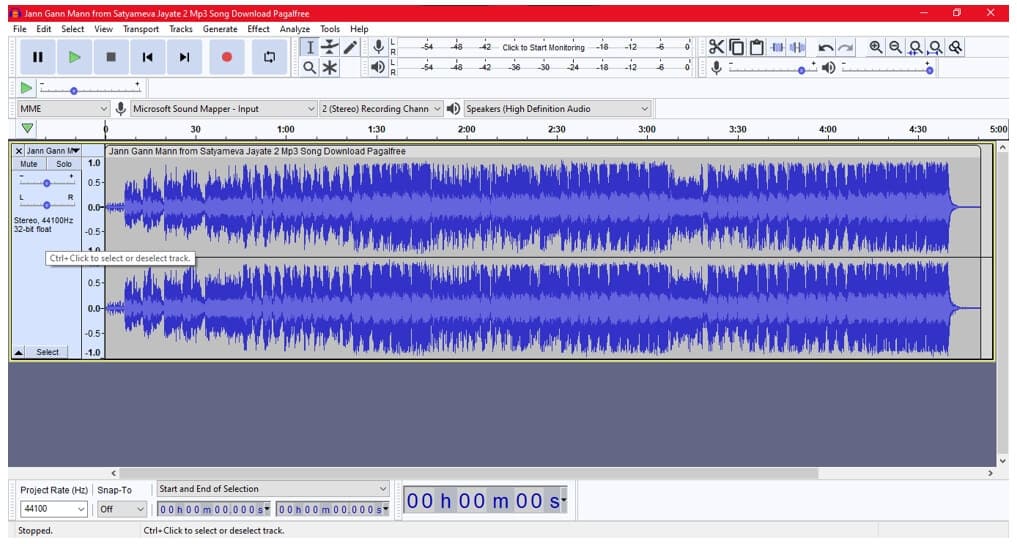
Note: Alternatively, you may also increase or increase the volume through the amplification process. To use this method, select the audio portion, access Effect, and tap Amplify. Tick allow clipping box and move the slider to set the volume of the sound.
Conclusion
There are high chances of audio sound not being in the required pitch or volume. Plus, you may also need to change the sound characteristics of an audio file for specific use. So, if this is the case, the Audacity change pitch technique is all you need to learn. Thus, we have summarized the process of changing pitch and volume in a step-by-step guide in this article. Hopefully, all your concerns will have been addressed.
02 How to Change Pitch in Audacity?
Part 1: What is pitch, and how does it work?
Not all sounds are the same. Some vary in terms of amplitude, which makes them loud or quiet. In contrast, others vary in terms of pitch, which makes them high or low. Pitch is used to differentiate between the acute and flat notes in a sound wave. High-pitched sounds are likely to be shrilling, whereas the lower-pitched will be bassy. Pitch depends upon the frequency of the sound waves producing them. In short, notes at a higher frequency are high-pitched.
On the contrary, notes at lower frequencies are low-pitched. Changing a pitch of noise from low to high or vice versa is an art. Thus, sound recording and editing applications like Audacity come with the in-built effect that enables you to change the pitch of a sound.
Part 2: How to Change Pitch in Audacity?
Sound editing is becoming increasingly popular in music and other relevant industries. Several applications offer sound editing tools to serve the needs of the people. Pitch-changing is one of the common tools that people look for in sound editors.
Audacity is one of the notable software that allows users to change the pitch of the voice. It comes with an Audacity pitch shift mechanism to facilitate users. So, if you are editing sound in Audacity, changing the pitch is just a matter of a few clicks. Are you still wondering how you can apply the Audacity change pitch technique when editing? Here’s how you can do it in simple steps.
Step 1: Select the audio portion
Launch Audacity and add sound recordings you want to edit. Click on the timeline and drag to select the portion of the sound.
Note: Only the portion whose pitch you want to change.

Step 2: Open Effect menu
Click on the Effect tab at the top right of the screen next to Generate. Select Pitch Change from the drop-down menu.
Note: You can also make other changes, such as Change Speed and Change Tempo option will let you alter the speed of the sound. So, the pitch can also be altered using this process.

Step 3: Adjust pitch
Drag the slider to alter the pitch of the sound and press the OK button to apply changes.
Note: To increase pitch, slide towards the right. Similarly, slide towards the left to a lower pitch. In addition, the pitch can also be changed by configuring From and To parameters.

Bonus Section: How to Adjust Sound Louder in Audacity?
Volume in an audio file may or may not be ideal for use. Sometimes, the sound is too loud or low. Audacity can help you in such a situation. So, if you are editing sound recordings in Audacity, you can also fix the volume of the sound. The good thing to note is that you can adjust the sound in both directions, which implies you can easily amplify or reduce the volume in these open-source applications. Are you interested in knowing about the volume adjustment process in Audacity? If yes, we have summarized the process in simple steps. Let’s take a look.
Step 1: Add an audio file
Launch the software and click on File. Select Open and select the desired audio.
Note: It is not recommended to change the volume through the playback volume knob at the top right corner of the screen, as this will only increase the volume in your device. However, the actual volume of the audio will remain unchanged.

Step 2: Increase/Decrease audio gain
Change the gain of the audio at the left-hand side of the screen. Move the slider to adjust the volume to the desired level.

Note: Alternatively, you may also increase or increase the volume through the amplification process. To use this method, select the audio portion, access Effect, and tap Amplify. Tick allow clipping box and move the slider to set the volume of the sound.
Conclusion
There are high chances of audio sound not being in the required pitch or volume. Plus, you may also need to change the sound characteristics of an audio file for specific use. So, if this is the case, the Audacity change pitch technique is all you need to learn. Thus, we have summarized the process of changing pitch and volume in a step-by-step guide in this article. Hopefully, all your concerns will have been addressed.
02 How to Change Pitch in Audacity?
Part 1: What is pitch, and how does it work?
Not all sounds are the same. Some vary in terms of amplitude, which makes them loud or quiet. In contrast, others vary in terms of pitch, which makes them high or low. Pitch is used to differentiate between the acute and flat notes in a sound wave. High-pitched sounds are likely to be shrilling, whereas the lower-pitched will be bassy. Pitch depends upon the frequency of the sound waves producing them. In short, notes at a higher frequency are high-pitched.
On the contrary, notes at lower frequencies are low-pitched. Changing a pitch of noise from low to high or vice versa is an art. Thus, sound recording and editing applications like Audacity come with the in-built effect that enables you to change the pitch of a sound.
Part 2: How to Change Pitch in Audacity?
Sound editing is becoming increasingly popular in music and other relevant industries. Several applications offer sound editing tools to serve the needs of the people. Pitch-changing is one of the common tools that people look for in sound editors.
Audacity is one of the notable software that allows users to change the pitch of the voice. It comes with an Audacity pitch shift mechanism to facilitate users. So, if you are editing sound in Audacity, changing the pitch is just a matter of a few clicks. Are you still wondering how you can apply the Audacity change pitch technique when editing? Here’s how you can do it in simple steps.
Step 1: Select the audio portion
Launch Audacity and add sound recordings you want to edit. Click on the timeline and drag to select the portion of the sound.
Note: Only the portion whose pitch you want to change.

Step 2: Open Effect menu
Click on the Effect tab at the top right of the screen next to Generate. Select Pitch Change from the drop-down menu.
Note: You can also make other changes, such as Change Speed and Change Tempo option will let you alter the speed of the sound. So, the pitch can also be altered using this process.

Step 3: Adjust pitch
Drag the slider to alter the pitch of the sound and press the OK button to apply changes.
Note: To increase pitch, slide towards the right. Similarly, slide towards the left to a lower pitch. In addition, the pitch can also be changed by configuring From and To parameters.

Bonus Section: How to Adjust Sound Louder in Audacity?
Volume in an audio file may or may not be ideal for use. Sometimes, the sound is too loud or low. Audacity can help you in such a situation. So, if you are editing sound recordings in Audacity, you can also fix the volume of the sound. The good thing to note is that you can adjust the sound in both directions, which implies you can easily amplify or reduce the volume in these open-source applications. Are you interested in knowing about the volume adjustment process in Audacity? If yes, we have summarized the process in simple steps. Let’s take a look.
Step 1: Add an audio file
Launch the software and click on File. Select Open and select the desired audio.
Note: It is not recommended to change the volume through the playback volume knob at the top right corner of the screen, as this will only increase the volume in your device. However, the actual volume of the audio will remain unchanged.

Step 2: Increase/Decrease audio gain
Change the gain of the audio at the left-hand side of the screen. Move the slider to adjust the volume to the desired level.

Note: Alternatively, you may also increase or increase the volume through the amplification process. To use this method, select the audio portion, access Effect, and tap Amplify. Tick allow clipping box and move the slider to set the volume of the sound.
Conclusion
There are high chances of audio sound not being in the required pitch or volume. Plus, you may also need to change the sound characteristics of an audio file for specific use. So, if this is the case, the Audacity change pitch technique is all you need to learn. Thus, we have summarized the process of changing pitch and volume in a step-by-step guide in this article. Hopefully, all your concerns will have been addressed.
02 How to Change Pitch in Audacity?
Part 1: What is pitch, and how does it work?
Not all sounds are the same. Some vary in terms of amplitude, which makes them loud or quiet. In contrast, others vary in terms of pitch, which makes them high or low. Pitch is used to differentiate between the acute and flat notes in a sound wave. High-pitched sounds are likely to be shrilling, whereas the lower-pitched will be bassy. Pitch depends upon the frequency of the sound waves producing them. In short, notes at a higher frequency are high-pitched.
On the contrary, notes at lower frequencies are low-pitched. Changing a pitch of noise from low to high or vice versa is an art. Thus, sound recording and editing applications like Audacity come with the in-built effect that enables you to change the pitch of a sound.
Part 2: How to Change Pitch in Audacity?
Sound editing is becoming increasingly popular in music and other relevant industries. Several applications offer sound editing tools to serve the needs of the people. Pitch-changing is one of the common tools that people look for in sound editors.
Audacity is one of the notable software that allows users to change the pitch of the voice. It comes with an Audacity pitch shift mechanism to facilitate users. So, if you are editing sound in Audacity, changing the pitch is just a matter of a few clicks. Are you still wondering how you can apply the Audacity change pitch technique when editing? Here’s how you can do it in simple steps.
Step 1: Select the audio portion
Launch Audacity and add sound recordings you want to edit. Click on the timeline and drag to select the portion of the sound.
Note: Only the portion whose pitch you want to change.

Step 2: Open Effect menu
Click on the Effect tab at the top right of the screen next to Generate. Select Pitch Change from the drop-down menu.
Note: You can also make other changes, such as Change Speed and Change Tempo option will let you alter the speed of the sound. So, the pitch can also be altered using this process.

Step 3: Adjust pitch
Drag the slider to alter the pitch of the sound and press the OK button to apply changes.
Note: To increase pitch, slide towards the right. Similarly, slide towards the left to a lower pitch. In addition, the pitch can also be changed by configuring From and To parameters.

Bonus Section: How to Adjust Sound Louder in Audacity?
Volume in an audio file may or may not be ideal for use. Sometimes, the sound is too loud or low. Audacity can help you in such a situation. So, if you are editing sound recordings in Audacity, you can also fix the volume of the sound. The good thing to note is that you can adjust the sound in both directions, which implies you can easily amplify or reduce the volume in these open-source applications. Are you interested in knowing about the volume adjustment process in Audacity? If yes, we have summarized the process in simple steps. Let’s take a look.
Step 1: Add an audio file
Launch the software and click on File. Select Open and select the desired audio.
Note: It is not recommended to change the volume through the playback volume knob at the top right corner of the screen, as this will only increase the volume in your device. However, the actual volume of the audio will remain unchanged.

Step 2: Increase/Decrease audio gain
Change the gain of the audio at the left-hand side of the screen. Move the slider to adjust the volume to the desired level.

Note: Alternatively, you may also increase or increase the volume through the amplification process. To use this method, select the audio portion, access Effect, and tap Amplify. Tick allow clipping box and move the slider to set the volume of the sound.
Conclusion
There are high chances of audio sound not being in the required pitch or volume. Plus, you may also need to change the sound characteristics of an audio file for specific use. So, if this is the case, the Audacity change pitch technique is all you need to learn. Thus, we have summarized the process of changing pitch and volume in a step-by-step guide in this article. Hopefully, all your concerns will have been addressed.
Audiophile’s Blueprint: Top Tools and Practices to Minimize External Sound Interference (On & Off)
Videos are like a hook that keeps us engaged for a good long time. Similarly, they are a great medium of information and entertainment. Good video content help us learn better and to memorize the information in it. However, this can be a problem when videos have issues like annoying background noises. Even distortion or jittery sound can turn a good-quality video into a poor source.
Nevertheless, there is a solution to almost every problem. There are tools that can help to remove distortion and background noises from a video. Such tools will help you reduce audio noise in the background or any distortion in your media file. You can download such software that will help you denoise your media content. In this way, your content will sound crispier and sharper with better audio quality.
Part 1: What Are The Benefits of Audio Denoising in Videos?
There are tools that will help you reduce noise from audio without any hassle. Such tools are very useful when it comes to removing distortion from your audio files. You can also denoise your files, but first, learn some of the benefits of audio denoising.
1. Clear Sound Quality
Audio denoising help to clear any unwanted noise, hiss, or any other background voice. This feature helps to improve the overall listening experience of the user. Once all the distortion is removed, the audio of your project will sound better and more polished.
2. Optimized Communication
Having clear and clean audio is important in videos for effective communication. Moreover, it makes sure that viewers can easily understand the dialogue or message. Better sound quality also improves the overall communication within the project or a video.
3. Professional and Factual
When there’s background noise or disturbances in the audio, the content appears to be faulty. It also can make the video less professional and not as trustworthy. If we remove the background noise, it helps the video to look more meaningful and professional.
4. Enhanced Audience Involvement
Clean sound keeps people interested and helps them stay attentive to the story. Moreover, people tend to be hooked more to the information in the video. It helps viewers to stay engaged, follow what’s happening, and enjoy watching the video.
5. Availability and Diversity
Reducing background noise makes the speech clearer and easier to follow. Additionally, when subtitles or captions are available, then it makes the video more captivating. This makes the videos more accessible to more people with diverse backgrounds.
6. Adjustable Editing Opportunities
Removing unwanted noise from the audio while editing a video gives us more flexibility. By doing so, you can work on your project later. Clean audio allows us to make accurate changes to the sound, like adjusting the volume or adding effects. Additionally, it makes your audio file better than before.
7. Uniformity and Uninterrupted Flow
By eliminating noise, each video part will have a similar sound profile. Meanwhile, this will create a smooth and uninterrupted audio experience for the viewers. Consistent audio quality is important in providing a seamless and unified viewing experience.
8. Audio Reconstruction
Eliminating such noises from audio is very helpful for fixing older or damaged recordings. It enhances the quality and makes it easier to understand audio. You can even reconstruct your old audio files and keep them safe. This will also help you to improve the quality of your old audio files.
Part 2: Wondershare Filmora: How To Denoise Audio Properly?
Wondershare Filmora is a comprehensive video editing software that features many effective video management tools . From video editing to denoise audio editing, everything is possible in Filmora. For those who are new to this tool, Filmora makes it very easy to manage such videos. To know how you can using Wondershare Filmora, look below into the steps:
Reduce Video/Audio Noise For Win 7 or later(64-bit)
Reduce Video/Audio Noise For macOS 10.14 or later
Step 1Add Audio with Noise on Filmora
On opening Filmora on your computer, continue to select the “New Project” button from the home screen. As this opens a window, continue to the “Import” options to add in the video or audio that needs editing. Drag and drop it to the timeline to continue with free audio noise removal.
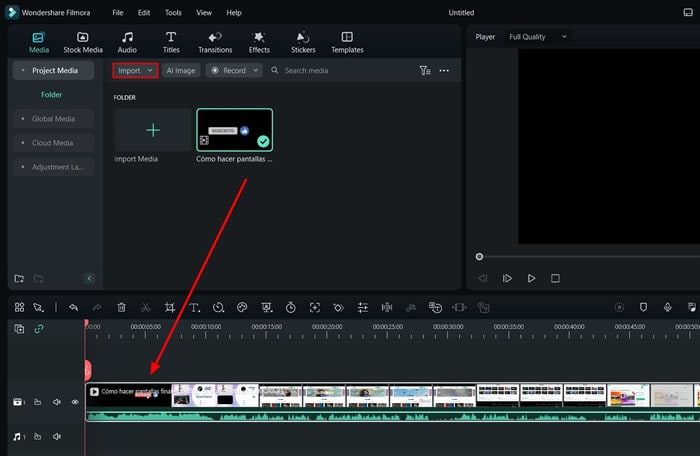
Step 2Adjust Audio Settings
As the media is imported successfully, right-click to open a list of options. Select “Adjust Audio” from the drop-down menu to open the audio settings on the screen.
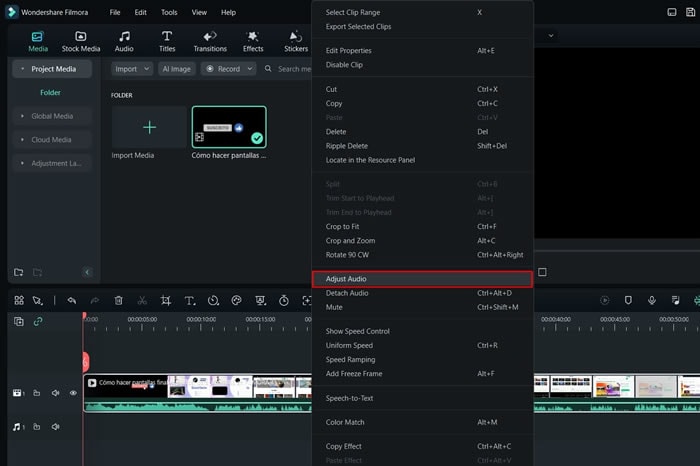
Step 3Successfully Denoise Audio
In the “Denoise” section, you can activate options such as “AI Speech Enhancement,” “Wind Removal,” and “Normal Denoise.” Also, you can set the sliders of “DeReverb,” “Hum Removal,” and “Hiss Removal.” After correcting the audio, click the “Export” button for opening the window to save the final product.
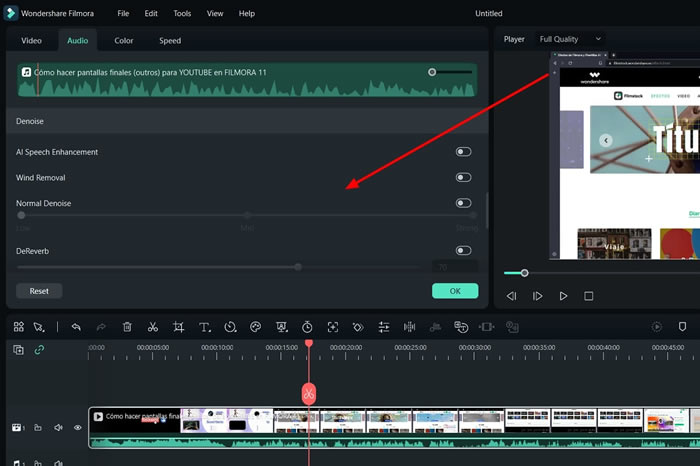
Part 3: Online Solutions: Reduce Audio Noise With The Right Tools
Your noise distortion or annoying background sounds is no more a hassle. These top 3 free audio noise removal online tools will help you with your problem. In this section, the steps of how to use these audio deniosers are also provided.
1. Media.io
Media.io is one of the most comprehensive video enhancers and editors out there. It can improve the quality of your images and also can edit your videos in a breeze. Besides this, it is also a great online audio noise reducer. You can import your audio files and simply let the tool eliminate all the distortion from your file.
Step 1: Access the online tool by going to its website. As you continue next, select the “Remove Noise Now” button to lead to a new window. Then, drag and drop your audio file from your system.
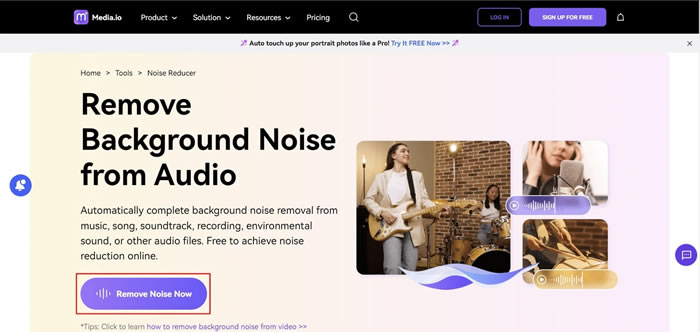
Step 2: Next, in the “Noise Reducer,” select the type of noise you want to remove from your audio file. You can select any of the provided options for removing the type of noise present in your content. Once selected, select the “Reduce noise now” button to initiate the process.
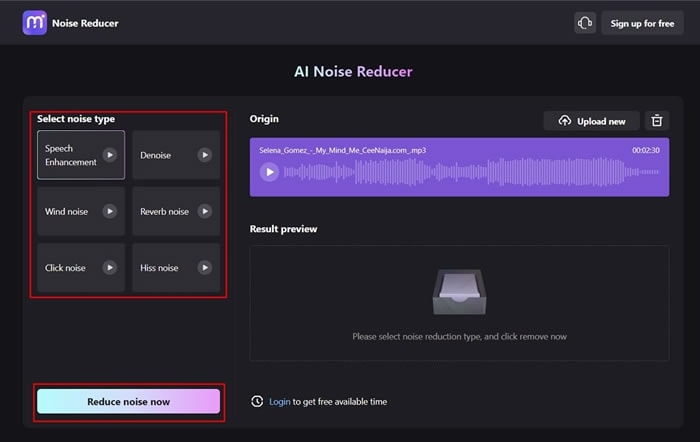
Step 3: Continue to preview your audio file under the “Result Preview” option. Proceed to download the file once completed by pressing “Download.”
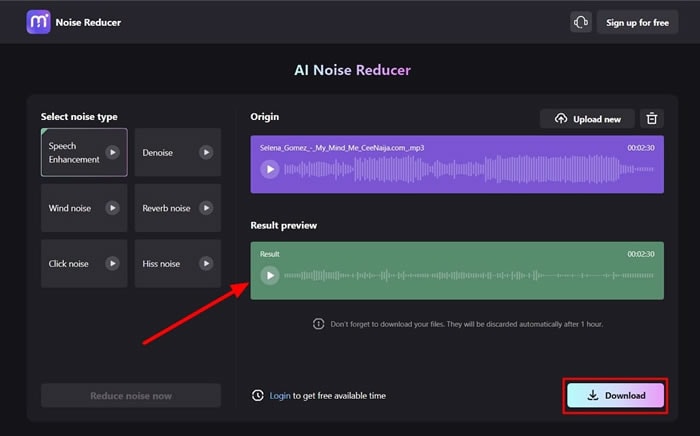
2. Veed.io
This online video editor provides a diversity of features to its users with qualitative assurance. Not only can you edit videos, but Veed.io provides the feasibility of editing audio. If you have recorded content with background noise, it can be easily removed using Veed.io . To know how this noise cancelling online tool works, follow the steps as follows:
Step 1: On opening the browser screen and navigating to the official link of Veed.io, click the “Clean your audio now” button.

Step 2: You will be led to a new window where you can add the distorted video or audio. Open importing it successfully on Veed.io, continue to the “Settings” section from the left, and look for the “Audio” settings.
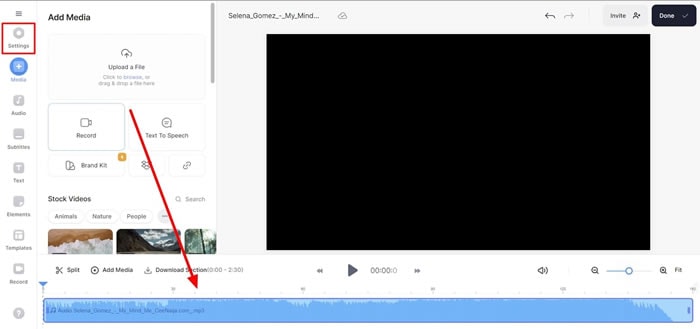
Step 3: To remove background noise from the audio, click the “Clean Audio” button and access “Done” from the top-right corner. Continue to export the video successfully from Veed.io background noise remover.
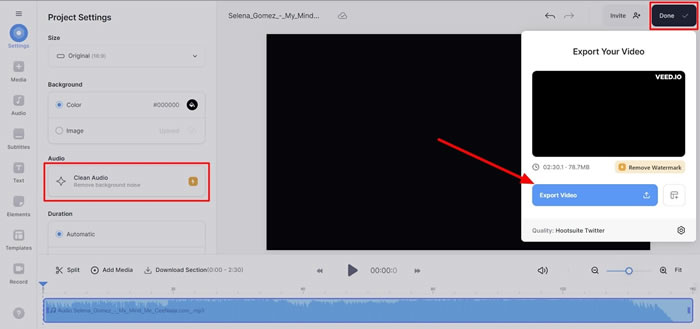
3. Kapwing
Another impressive online video editor, Kapwing , provides its users with the option of removing noise from audio. With a clean and simple interface, it is not difficult to reduce audio noise through Kapwing. For an understanding of how this audio noise reduction online free tool works, follow the steps below explaining the operations of Kapwing:
Step 1: As you access the online webpage of Kapwing, click the “Upload video or audio” button to continue further.
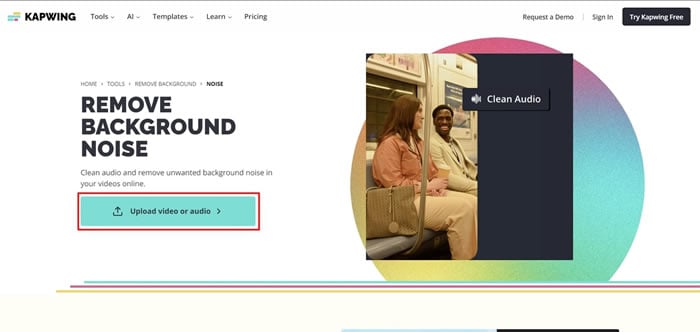
Step 2: As you tap the “Upload” button on the new window and add your video, a new editing section opens on the right panel.
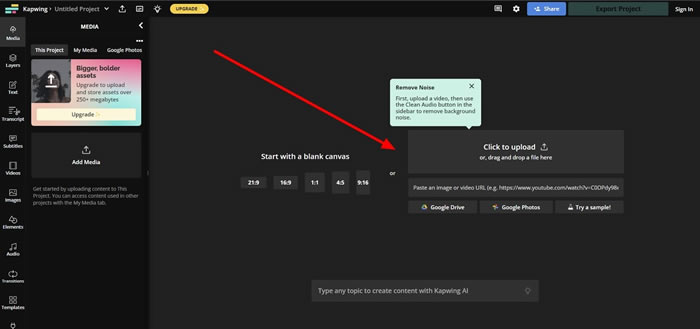
Step 3: Look for the “Clean Audio” button in the “AI Tools” section on the right to remove the audio noise from the added media. Once it is done, click the “Export Project” button on the top to download the edited video successfully.
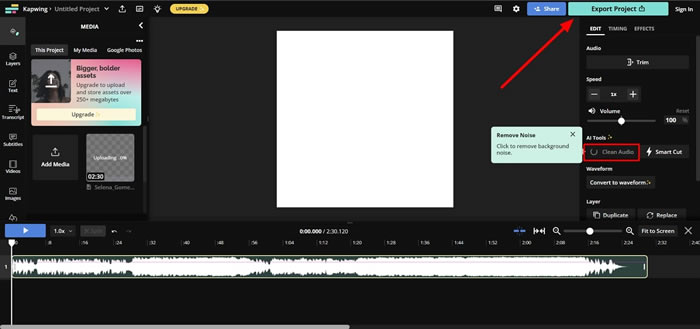
Conclusion
To conclude, videos are a great source of entertainment and information for almost everyone. So, why go for a video with too much distortion and jitters? Wondershare Filmora has added an excellent feature to denoise your video or audio files . This tool has a feature to reduce or remove background noises or distortion from your videos. With this feature, your video files will have a more clear and sharp audio sound.
Reduce Video/Audio Noise For Win 7 or later(64-bit)
Reduce Video/Audio Noise For macOS 10.14 or later
Reduce Video/Audio Noise For macOS 10.14 or later
Step 1Add Audio with Noise on Filmora
On opening Filmora on your computer, continue to select the “New Project” button from the home screen. As this opens a window, continue to the “Import” options to add in the video or audio that needs editing. Drag and drop it to the timeline to continue with free audio noise removal.

Step 2Adjust Audio Settings
As the media is imported successfully, right-click to open a list of options. Select “Adjust Audio” from the drop-down menu to open the audio settings on the screen.

Step 3Successfully Denoise Audio
In the “Denoise” section, you can activate options such as “AI Speech Enhancement,” “Wind Removal,” and “Normal Denoise.” Also, you can set the sliders of “DeReverb,” “Hum Removal,” and “Hiss Removal.” After correcting the audio, click the “Export” button for opening the window to save the final product.

Part 3: Online Solutions: Reduce Audio Noise With The Right Tools
Your noise distortion or annoying background sounds is no more a hassle. These top 3 free audio noise removal online tools will help you with your problem. In this section, the steps of how to use these audio deniosers are also provided.
1. Media.io
Media.io is one of the most comprehensive video enhancers and editors out there. It can improve the quality of your images and also can edit your videos in a breeze. Besides this, it is also a great online audio noise reducer. You can import your audio files and simply let the tool eliminate all the distortion from your file.
Step 1: Access the online tool by going to its website. As you continue next, select the “Remove Noise Now” button to lead to a new window. Then, drag and drop your audio file from your system.

Step 2: Next, in the “Noise Reducer,” select the type of noise you want to remove from your audio file. You can select any of the provided options for removing the type of noise present in your content. Once selected, select the “Reduce noise now” button to initiate the process.

Step 3: Continue to preview your audio file under the “Result Preview” option. Proceed to download the file once completed by pressing “Download.”

2. Veed.io
This online video editor provides a diversity of features to its users with qualitative assurance. Not only can you edit videos, but Veed.io provides the feasibility of editing audio. If you have recorded content with background noise, it can be easily removed using Veed.io . To know how this noise cancelling online tool works, follow the steps as follows:
Step 1: On opening the browser screen and navigating to the official link of Veed.io, click the “Clean your audio now” button.

Step 2: You will be led to a new window where you can add the distorted video or audio. Open importing it successfully on Veed.io, continue to the “Settings” section from the left, and look for the “Audio” settings.

Step 3: To remove background noise from the audio, click the “Clean Audio” button and access “Done” from the top-right corner. Continue to export the video successfully from Veed.io background noise remover.

3. Kapwing
Another impressive online video editor, Kapwing , provides its users with the option of removing noise from audio. With a clean and simple interface, it is not difficult to reduce audio noise through Kapwing. For an understanding of how this audio noise reduction online free tool works, follow the steps below explaining the operations of Kapwing:
Step 1: As you access the online webpage of Kapwing, click the “Upload video or audio” button to continue further.

Step 2: As you tap the “Upload” button on the new window and add your video, a new editing section opens on the right panel.

Step 3: Look for the “Clean Audio” button in the “AI Tools” section on the right to remove the audio noise from the added media. Once it is done, click the “Export Project” button on the top to download the edited video successfully.

Conclusion
To conclude, videos are a great source of entertainment and information for almost everyone. So, why go for a video with too much distortion and jitters? Wondershare Filmora has added an excellent feature to denoise your video or audio files . This tool has a feature to reduce or remove background noises or distortion from your videos. With this feature, your video files will have a more clear and sharp audio sound.
Reduce Video/Audio Noise For Win 7 or later(64-bit)
Reduce Video/Audio Noise For macOS 10.14 or later
Also read:
- [New] 2024 Approved 5 Key Steps to Transforming Videos Into Cash on Vimeo
- [New] In 2024, Your Quick Pathway to iPad Time-Lapse Success
- [New] Quintessential 5 Add-Ons for Sea Cameras
- [New] Securing Your Speech on the iPad for 2024
- [New] Upgrade Your Facebook Experience with the Best 5 Extensions for 2024
- [Updated] In 2024, InstaGrabs Top 15 Video/Photo Downloading Tools
- [Updated] The 411 on Building Sports Video Gold for 2024
- 2024 Approved Elite Tips for Professional Music Video Editing
- Clearer Sounds, Cleaner Listening Approaches to Dismiss Environmental Hiss and Hum for 2024
- Elevate Your Street Fighter 6 Experience: A Step-by-Step Guide to Solving Lag and Improving Connection Quality on PC
- New Masters List Eliminating Window-Based Background Sounds From Your Recordings for 2024
- New The Elite Selection of Virtual Audio Editing Experts for 2024
- Seeking Out Wolves Haunting Howls in Audio Form
- Streamlining Post Production with After Effects and LUTs
- Superior Suggestions Top Websites for Acquiring SnapAlert Melodies for 2024
- Ultimate Car Audio Blend Tool for Mac Users for 2024
- Updated 2024 Approved Hearing Locations of Exasperated Dogs Communicating Through Bark
- Updated In 2024, Adding Audiovisual Elements in Cinema Pro Step-by-Step Guide
- Updated Understanding Pexels.com A Resource for High-Quality, Creative Commons Images
- Title: MP4 File Optimization Removing Unwanted Audio Tracks
- Author: Kate
- Created at : 2024-10-22 19:40:02
- Updated at : 2024-10-23 19:26:08
- Link: https://audio-editing.techidaily.com/mp4-file-optimization-removing-unwanted-audio-tracks/
- License: This work is licensed under CC BY-NC-SA 4.0.

